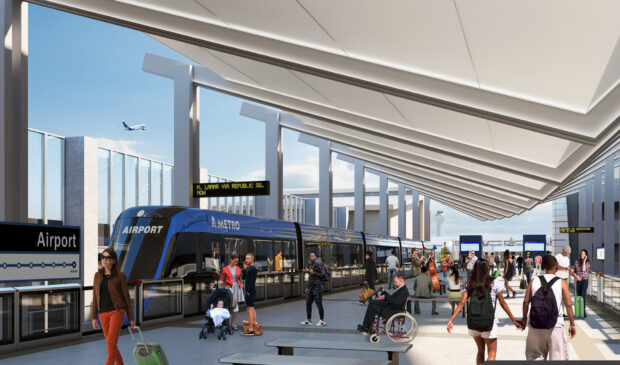Transit leaders preparing new Project Connect scenarios for March open house
Friday, March 10, 2023 by
Chad Swiatecki With a budget that no longer meets the vision approved by voters in 2020 for an ambitious mass transit system, leaders with the agency charged with carrying out the Project Connect plan say that work continues to decide what the first phase of the system will look like.
The Blue Line portion serving downtown and potentially points to the south and east will likely be the focus of the scenarios revealed on March 21 when Austin Transit Partnership hosts an open house at Austin Central Library on West Cesar Chavez Street. At that session, the public will see the possible iterations of the Blue Line and the light rail infrastructure that has to be reimagined due to forecasts putting the system cost at $11.6 billion, or roughly double the cost of the plan approved by voters.
Those in local transit circles worry that eliminating a rail line across the river or running rail lines at street grade rather than underground or overhead would reduce the effectiveness of the system because of competition with downtown traffic.
Greg Canally, recently appointed as executive director of ATP, said much consideration is being given to the downtown portion of the system while trying to stay within the budget floated before voters.
“We’re still finalizing that work, kind of working day and night as we get ready for a kickoff event, and I think the public is going to see some good options about how we not only get through downtown, we have to remember downtown is really important, but other parts of the community that we can serve,” he said. “And we’re going to show some of that work that we’ve done from a design perspective and from an engineering perspective and (we’re) excited to get the feedback from the community.”
The cost increase – due to a combination of rising labor and land prices and revisions made due to engineering and geology – has prompted a group of state lawmakers to propose legislation that, if passed, would prohibit the city from issuing further debt for the project without another approval from voters.
In a Fast Company story about the transit project that ran on Thursday, designers said using modular design components for some of the transit stations could reduce material costs and reduce the construction time of those parts of the project.
Canally said ATP is continuing to look for similar ways to optimize the project and prove its effectiveness in hopes of securing additional federal support.
“We’re working with our partners at the city and Cap Metro, making sure that we were delivering on the core of what Austinites wanted, which was better connections and (an) enhanced transit system. Light rail will be a component of our existing transit system. We make sure that those key interfaces are good and we want to make sure that we’re delivering (as much of) the system that we can,” he said. “We have a great working relationship with the Federal Transit Administration and we want to show a great project that is going to get the most federal dollars that we can get. We’re going to try to optimize our revenue to get a great investment from the federal government to do that.”
Mayor Pro Tem Paige Ellis said increasing real estate costs throughout the city removes pausing the project as an option for dealing with the rising costs. She said equity needs to be considered along with commercial and residential density when deciding on the possible revisions to the system.
“It’s important we strategically target dense residential and commercial areas to achieve the greatest early ridership, but we also need to be mindful of connectivity and equity,” she said via email. “For instance, if the line goes from UT to St. Edward’s in the first phase, there will need to be a connection to Crestview shortly after to better connect with the Red Line already in operation. Alternatively, if South of the river doesn’t get substantial rail in the first phase as I believe it should, we have to prioritize it in the next phase.”
Bill McCamley, executive director of the transit education agency Transit Forward, said the public expects the pieces of Project Connect to begin coming online soon and local transit leaders will need to handle the system in phases due to the cost issues.
“We believe all the parts of Project Connect, the rail, bus service and anti-displacement funds, all are critical for a growing city like ours,” he said. “We want to make sure people understand how critical moving forward with Project Connect is for affordability, safety and to reduce traffic. There’s an honest conversation going on about the cost situation we find ourselves in … but it is really vital for us as a community that Project Connect moves forward.”
The Austin Monitor’s work is made possible by donations from the community. Though our reporting covers donors from time to time, we are careful to keep business and editorial efforts separate while maintaining transparency. A complete list of donors is available here, and our code of ethics is explained here.
You're a community leader
And we’re honored you look to us for serious, in-depth news. You know a strong community needs local and dedicated watchdog reporting. We’re here for you and that won’t change. Now will you take the powerful next step and support our nonprofit news organization?






